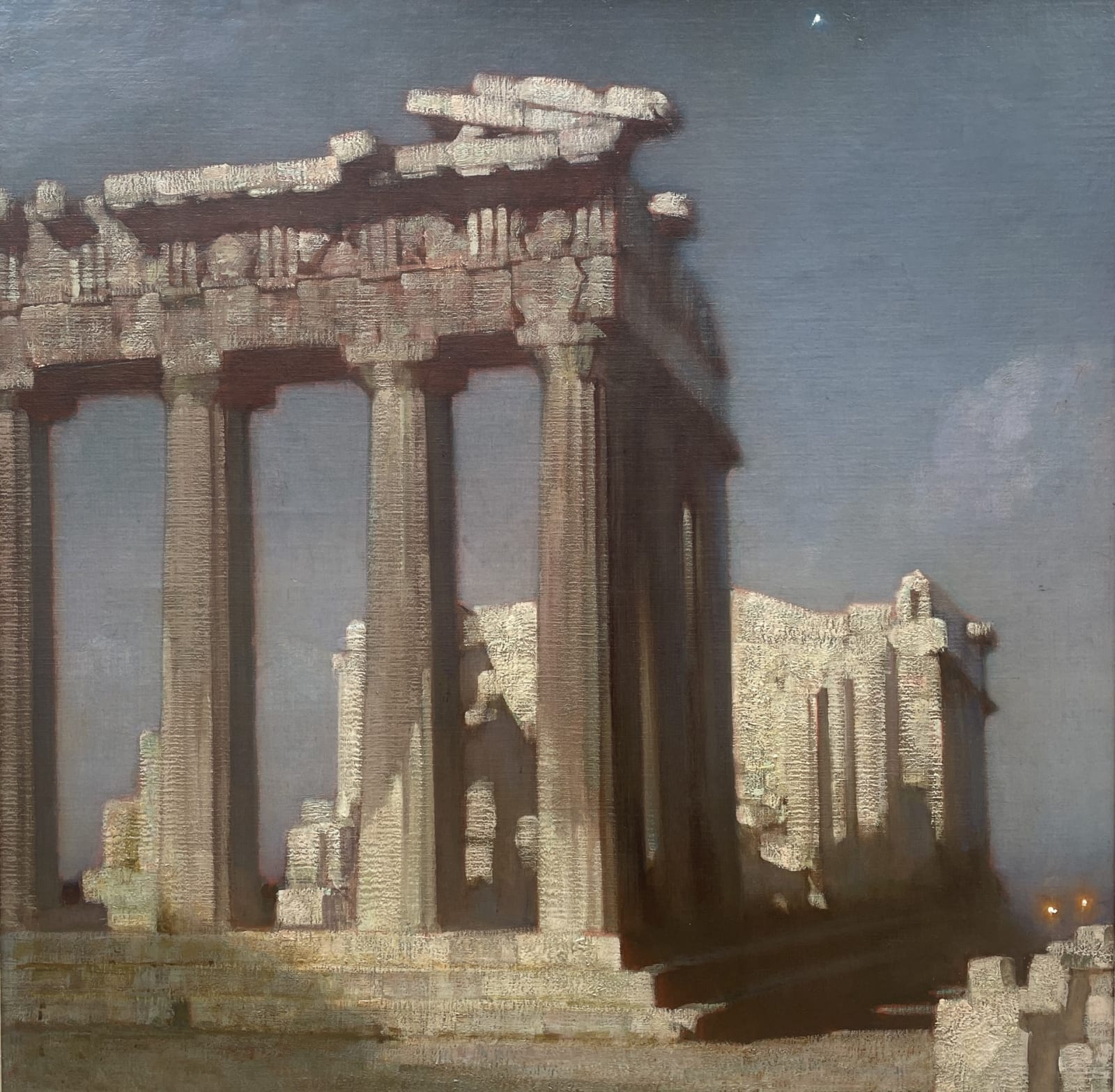Harold Speed
The Parthenon
Oil on canvas
91.5 x 91.5 cm
The painting comes from the private collection of Mr Wilson who lived in the same house as Speed, 23 Campden Hill Square (W8). In the 1890s, it was the home of the Llewelyn Davies family; the four boys of the family became the inspiration for J.M. Barrie's Peter Pan. Harold Speed owned the house from 1920 until his death in 1957. From 1925-1932 the writer and poet Siegfried Sassoon was one of his tenants there, during which time he wrote, Memoirs of a Fox Hunting Man (1928) and Memoirs of an Infantry Officer (1930).
Harold Speed was a portrait and landscape painter active throughout the first half of the twentieth century. As well as landscape and mythological subjects, he painted numerous portraits of eminent men and women. His early travels in Italy and Europe gave his work a classical European nuance and the illustrated painting shows this influence clearly.
The pose of the sitter and the sumptuous sleeve and hair piece are strongly reminiscent of Venetian Renaissance painters such as Paulo Veronese (‘Portrait of a Lady’ - Musée de la Chartreuse, Douai) and Titian (‘Man with a Blue Sleeve’ - National Gallery, London) At the same time, there is a suggestion of the sensuality of the Pre Rapahelites, notably Veronica Veronese by Dante Gabriel Rossetti, 1872. (Bancroft Collection, Wilmington Society of Fine Arts, Delaware, USA)
Speed was born on 11 February 1872 in London, the son of architect Edward Speed. In 1897 he too started to train as an architect at the Royal College of Art, but chose in 1891 to study painting at the Royal Academy Schools which he did until 1896.
Speed won a gold medal at the RAS in 1893 and a travelling scholarship to Belgium, France, Italy and Spain in 1894. He began his fifty year history of exhibiting at the Royal Academy in 1893, and was elected a member of the Royal Society of Portrait Painters in 1895. By 1906 he was an associate of the Société Nationale des Beaux-Arts, Paris and his first one-man exhibition was at the Leicester Galleries in 1907. Nine years later in 1916 he became Master of the Art Worker’s Guild. During the period 1895-6 he painted the fresco ‘Autumn’ in the lunette of the restaurant in the Royal Academy, whose companion piece 'Spring Driving Away Winter' was painted by Fred Appleyard in 1902.
Throughout his life he retained a series of houses in London, latterly 23 Campden Hill Square W8, but in later life he mainly lived at Court Meadow, Watlington, Oxfordshire, where he died on 20th March 1957.
For many years, Speed’s name has remained prominent through a number of practical treatises on painting technique; The Science and Practice of Drawing (1913), The Science and Practice of Oil Painting (1924) and What is the Good of Art? (1936). These handbooks are still in print and are essential reading for today’s figurative artists.
Museums: Tate Britain, National Portrait Gallery, Southampton City Art Gallery, Belfast City Hall, & Birmingham.
Published in: Mary Chamot, Dennis Farr and Martin Butlin, The Modern British Paintings, Drawings and Sculpture, London 1964, II (Tate Gallery)
The pose of the sitter and the sumptuous sleeve and hair piece are strongly reminiscent of Venetian Renaissance painters such as Paulo Veronese (‘Portrait of a Lady’ - Musée de la Chartreuse, Douai) and Titian (‘Man with a Blue Sleeve’ - National Gallery, London) At the same time, there is a suggestion of the sensuality of the Pre Rapahelites, notably Veronica Veronese by Dante Gabriel Rossetti, 1872. (Bancroft Collection, Wilmington Society of Fine Arts, Delaware, USA)
Speed was born on 11 February 1872 in London, the son of architect Edward Speed. In 1897 he too started to train as an architect at the Royal College of Art, but chose in 1891 to study painting at the Royal Academy Schools which he did until 1896.
Speed won a gold medal at the RAS in 1893 and a travelling scholarship to Belgium, France, Italy and Spain in 1894. He began his fifty year history of exhibiting at the Royal Academy in 1893, and was elected a member of the Royal Society of Portrait Painters in 1895. By 1906 he was an associate of the Société Nationale des Beaux-Arts, Paris and his first one-man exhibition was at the Leicester Galleries in 1907. Nine years later in 1916 he became Master of the Art Worker’s Guild. During the period 1895-6 he painted the fresco ‘Autumn’ in the lunette of the restaurant in the Royal Academy, whose companion piece 'Spring Driving Away Winter' was painted by Fred Appleyard in 1902.
Throughout his life he retained a series of houses in London, latterly 23 Campden Hill Square W8, but in later life he mainly lived at Court Meadow, Watlington, Oxfordshire, where he died on 20th March 1957.
For many years, Speed’s name has remained prominent through a number of practical treatises on painting technique; The Science and Practice of Drawing (1913), The Science and Practice of Oil Painting (1924) and What is the Good of Art? (1936). These handbooks are still in print and are essential reading for today’s figurative artists.
Museums: Tate Britain, National Portrait Gallery, Southampton City Art Gallery, Belfast City Hall, & Birmingham.
Published in: Mary Chamot, Dennis Farr and Martin Butlin, The Modern British Paintings, Drawings and Sculpture, London 1964, II (Tate Gallery)
Provenance
Private Collection UK
Private Collection UK
1
of
2
